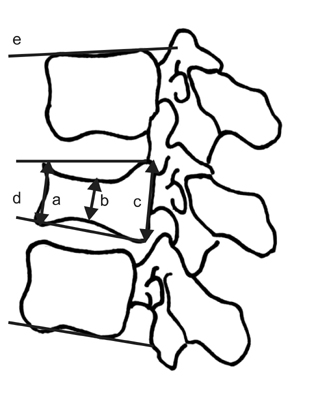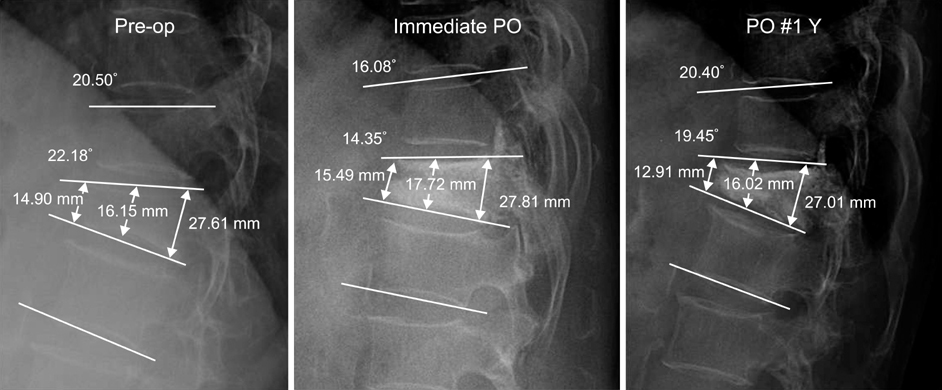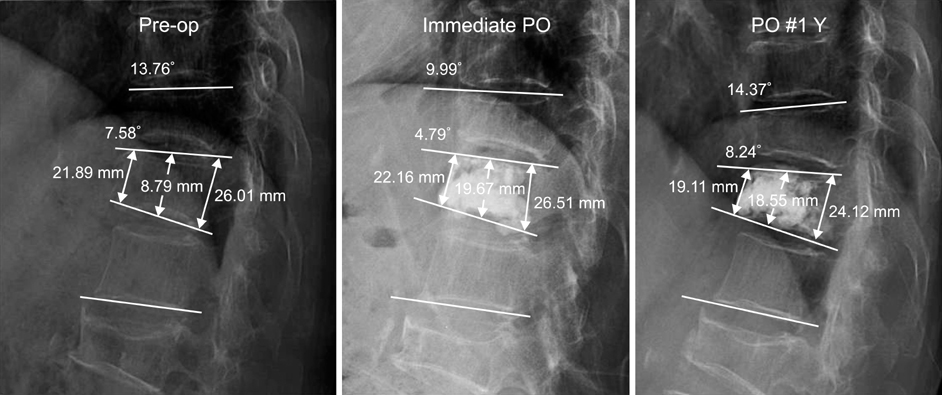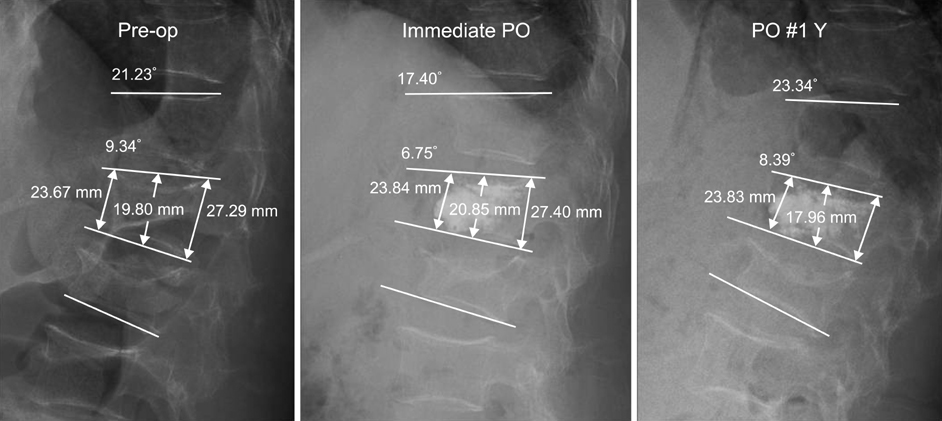Articles
- Page Path
- HOME > J Musculoskelet Trauma > Volume 23(1); 2010 > Article
-
Original Article
- The Effect of Adjacent Vertebral Body on Vertebroplasty for Compression Fracture
- Yong-Chan Kim, M.D., Ho-Geun Chang, M.D., Kee-Byung Lee, M.D.
-
Journal of the Korean Fracture Society 2010;23(1):97-103.
DOI: https://doi.org/10.12671/jkfs.2010.23.1.97
Published online: January 31, 2010
Department of Orthopedic Surgery, Hallym University Sacred Heart Hospital, School of Medicine, Hallym University, Anyang, Korea.
- Address reprint requests to: Ho-Geun Chang, M.D. Department of Orthopedic Surgery, Hallym University Sacred Heart Hospital, 896, Pyeongchon-dong, Dongan-gu, Anyang 431-070, Korea. Tel: 82-31-380-6000, Fax: 82-31-380-6008, yckim@hallym.or.kr
• Received: November 26, 2009 • Revised: January 2, 2010 • Accepted: January 12, 2010
Copyright © 2010 The Korean Fracture Society
- 506 Views
- 1 Download
- 2 Crossref
Abstract
-
Purpose
- To analyze the effect of adjacent vertebral body on local sagittal segment in performing vertebroplasty for thoracolumabr vertebral compression fracture on the terms of radiological results.
-
Materials and Methods
- We experienced 61 cases of T12 and L1 Compression fracture between June 2003 and November 2005. We classified with 3 groups; no collapse of adjacent body, collapse of adjacent upper body, and collapse of adjacent lower body. The measuring factors were anterior, middle, posterior vertebral height, wedge angle and local kyphotic angle.
-
Results
- In group I, Increase rate of anterior, middle, posterior vertebral height and restoration rate of wedge angle, and local kyphotic angle were average of 0.41%, 0.31%, 0.16%, 1.47%, -3.48% respectively. Group II was -3.19%, 0.11%, -3.02%, -1.23%, -4.63%. Group III was -2.28%, 4.72%, -1.01%, -2.41%, -13.12%. There are no significant differences among the groups except local kyphotic angle in Group III statistically.
-
Conclusion
- The previous wedged collapse of adjacent vertebral body do not affect local sagittal segment performed vertebroplasty in the thoracolumbar compression fracture. However the previous wedged collapse of adjacent lower body affect significantly local kyphotic angle.
- 1. Alvarez L, Pérez-Higueras A, Quiñones D, Calvo E, Rossi RE. Vertebroplasty in the treatment of vertebral tumors: postprocedural outcome and quality of life. Eur Spine J, 2003;12:356-360.ArticlePDF
- 2. Baráth K, Martin JB, Fasel HJ, et al. Percutaneous vertebroplasty: method indications, results. Orv Hetil, 2002;143:2469-2477.
- 3. Baroud G, Heini P, Nemes J, Bohner M, Ferguson S, Steffen T. Biomechanical explanation of adjacent fractures following vertebroplasty. Radiology, 2003;229:606-607.Article
- 4. Baroud G, Nemes J, Heini P, Steffen T. Load shift of the intervertebral disc after a vertebroplasty: a finite-element study. Eur Spine J, 2003;12:421-426.
- 5. Barr JD, Barr MS, Lemley TJ, McCann RM. Percutaneous vertebroplasty for pain relief and spinal stabilization. Spine, 2000;25:923-928.
- 6. Berlemann U, Ferguson SJ, Nolte LP, Heini PF. Adjacent vertebral failure after vertebroplasty. A biomechanical investigation. J Bone Joint Surg Br, 2002;84:748-752.
- 7. Cho YS, Cho SD, Kim BS, Park TW, Lew SU, Cho SH. Percutaneous vertebroplasty on osteoporotic compressive fracture. J Korean Orthop Assoc, 2002;37:13-18.
- 8. Cotten A, Dewatre F, Cortet B, et al. Percutaneous vertebroplasty for osteolytic metastases and myeloma: effects of the percentage of lesion filling and the leakage of methyl methacrylate at clinical follow-up. Radiology, 1996;200:525-530.
- 9. Deramond H, Depriester C, Galibert P, Le Gars D. Percutaneous vertebroplasty with polymethylmethacrylate. Technique, indications, and results. Radiol Clin North Am, 1998;36:533-546.
- 10. Diamond TH, Champion B, Clark WA. Management of acute osteoporotic vertebral fractures: a nonrandomized trial comparing percutaneous vertebroplasty with conservative therapy. Am J Med, 2003;114:257-265.
- 11. Galibert P, Deramond H, Rosat P, Le Gars D. Note preliminaire sur le traitenent des angiomes vertebraux par vertebroplastie acrylique percutanee. Neurochirurgie, 1987;33:166-168.
- 12. Galibert P, Déramond H. Percutaneous acrylic vertebroplasty as a treatment of vertebral angioma as well as painful and debilitating diseases. Chirurgie, 1990;116:326-334.
- 13. Gangi A, Guth S, Imbert JP, Marin H, Dietmann JL. Percutaneous vertebroplasty: indications, technique, and results. Radiographics, 2003;23:e10.
- 14. Garfin SR, Yuan HA, Reiley MA. New technologies in spine: kyphoplasty and vertebroplasty for the treatment of painful osteoporotic compression fractures. Spine (Phila Pa 1976), 2001;26:1511-1515.
- 15. Hiwatashi A, Moritani T, Numaguchi Y, Westesson PL. Increase in vertebral body height after vertebroplasty. AJNR Am J Neuroradiol, 2003;24:185-189.
- 16. Kaplan FS, Scherl JD, Wisneski R, Cheatle M, Haddad JG. The cluster phenomenon in patients who have multiple vertebral compression fractures. Clin Orthop, 1993;297:161-167.
- 17. Kim MH, Min SH, Jeon SH. Risk factors of new compression fractures in adjacent vertebra after percutaneous vertebroplasty. J Korean Fract Soc, 2007;20:260-265.
- 18. Kim WJ, Yeom JS, Kang JW, et al. Percutaneous vertebroplasty: short-term results of 38cases. J Korean Orthop Assoc, 2002;37:471-477.
- 19. Kim YW. Percutaneous vertebral augmentation for osteoporotic vertebral compression fractures. J Korean Fract Soc, 2009;22:218-223.
- 20. Na HY, Cho HW, Kim SK, Lee SY. Comparison of outcome between percutaneous vertebroplasty and kyphoplasty for osteoporotic painful vertebral compression fracture. J Korean Soc Spine Surg, 2003;10:127-136.
- 21. Polikeit A, Nolte LP, Ferguson SJ. The effect of cement augmentation on the load transfer in an osteoporotic functional spinal unit: finite-element analysis. Spine (Phila Pa 1976), 2003;28:991-996.
- 22. Teng MM, Wei CJ, Wei LC. Kyphosis correction and height restoration effects of percutaneous vertebroplasty. AJNR Am J Neuroradiol, 2003;24:1893-1900.
REFERENCES
Fig. 1Diagram showing the measurements made on the sagittal segments. a: anterior vertebral height, b: middle vertebral height, c: posterior vertebral height, d: wedge angle, e: local kyphotic angle.


Fig. 2A 76-year-old woman with compression fracture T12 (Group I). There is no significant difference between all measuring factors.


Fig. 3A 74-year-old woman with compression fracture T12 (Group II). There is no significant difference between all measuring factors.


Figure & Data
REFERENCES
Citations
Citations to this article as recorded by 

- Survival Rate and Risk Factor Analysis in Patients Who Experience a New Fracture after Kyphoplasty
Jung-Hoon Kim, Dong-Hyok Kim
Journal of Korean Society of Spine Surgery.2018; 25(3): 99. CrossRef - Survival Rate and Risk Factor Analysis in Patients Who Experience a New Fracture after Kyphoplasty
Jung-Hoon Kim, Dong-Hyok Kim
Journal of Korean Society of Spine Surgery.2018; 25(3): 99. CrossRef
The Effect of Adjacent Vertebral Body on Vertebroplasty for Compression Fracture




Fig. 1
Diagram showing the measurements made on the sagittal segments. a: anterior vertebral height, b: middle vertebral height, c: posterior vertebral height, d: wedge angle, e: local kyphotic angle.
Fig. 2
A 76-year-old woman with compression fracture T12 (Group I). There is no significant difference between all measuring factors.
Fig. 3
A 74-year-old woman with compression fracture T12 (Group II). There is no significant difference between all measuring factors.
Fig. 4
A 69-year-old woman with compression fracture L1(Group III). There is no significant difference between all measuring factors except local kyphotic angle.
Fig. 1
Fig. 2
Fig. 3
Fig. 4
The Effect of Adjacent Vertebral Body on Vertebroplasty for Compression Fracture
Changes over time in anterior vertebral body height (mm), Increase rate (%)
Changes over time in middle vertebral body height (mm), increase rate (%)
Changes over time in posterior vertebral body height (mm), increase rate (%)
Changes over time in local kyphotic angle, restoration rate (%)
Changes over time in wedge angle, restoration rate (%)
Table 1
Changes over time in anterior vertebral body height (mm), Increase rate (%)
Table 2
Changes over time in middle vertebral body height (mm), increase rate (%)
Table 3
Changes over time in posterior vertebral body height (mm), increase rate (%)
Table 4
Changes over time in local kyphotic angle, restoration rate (%)
Table 5
Changes over time in wedge angle, restoration rate (%)

 E-submission
E-submission KOTA
KOTA TOTA
TOTA TOTS
TOTS






 Cite
Cite

